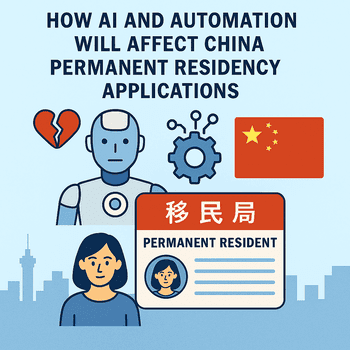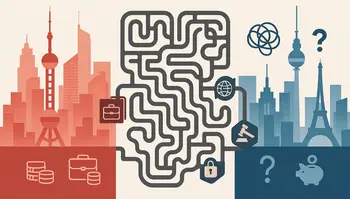
China’s permanent residency system is changing fast. The country is using new technology to make the application process better.
AI and automation are key parts of this change. These tools will affect how foreigners apply for China’s “green card.”
This guide explains what these changes mean for you. We’ll look at current trends and future developments. You’ll learn how to prepare for the new digital system.
Current State of China’s Permanent Residency System
China’s permanent residency program has been strict for many years.
The People’s Republic of China Foreign Permanent Resident ID Card, colloquially referred to as the PR Card, Green Card or Five-Star Card by expats, is an identity document for permanent residents in China.
Only about 10,000 foreigners have received permanent residency since 2004.
The process today involves multiple steps:
- Document collection and verification
- Background checks
- Interview processes
- Medical examinations
- Financial verification
These steps often take 6 to 12 months to complete. The manual review process creates delays and inconsistencies.
Traditional Application Challenges
Current applicants face several problems:
- Long waiting times: Manual processing creates bottlenecks
- Complex paperwork: Multiple forms require careful completion
- Inconsistent standards: Different offices may have varying requirements
- Limited transparency: Applicants often don’t know their status
The Rise of AI in Chinese Government Services
By 2025, the State Council aims for China to make fundamental contributions to basic AI theory and to solidify its place as a global leader in AI research.
This commitment extends to government services, including immigration processes.
China has already started using AI in various sectors:
- Healthcare systems use AI for diagnosis
- Financial services employ automated risk assessment
- Public security systems utilize facial recognition
- Traffic management uses smart algorithms
Digital Government Initiative
The Chinese government wants to digitize all public services by 2025.
This plan includes immigration and permanent residency applications.
The goal is to create a “one-stop” digital platform for all government interactions.
AI Technologies Transforming Application Processes
Several AI technologies will change how permanent residency applications work:
Document Processing and Verification
AI systems can read and verify documents quickly.
Optical Character Recognition (OCR) technology extracts information from scanned papers.
Machine learning algorithms check for authenticity and completeness.
Benefits include:
- Faster document review
- Reduced human error
- Automatic translation services
- Real-time verification
Automated Background Checks
AI systems can perform background checks much faster than humans.
They search multiple databases simultaneously and cross-reference information from various sources.
Key improvements:
- Comprehensive database searches
- Pattern recognition for risk assessment
- Real-time updates from multiple agencies
- Automated risk scoring
Predictive Analytics for Application Success
AI can analyze successful applications to predict approval chances.
This helps both applicants and immigration officers understand requirements better.
Applications include:
- Success probability calculations
- Requirement gap analysis
- Personalized application guidance
- Resource allocation optimization
Impact on Application Timelines and Efficiency
AI and automation will significantly reduce processing times. Here’s what experts predict:
| Current Process | AI-Enhanced Process | Time Reduction |
|---|---|---|
| Document Review | Automated OCR + Verification | 70-80% faster |
| Background Checks | AI Database Search | 85-90% faster |
| Initial Assessment | Automated Scoring | 60-70% faster |
| Overall Timeline | 6-12 months | 2-4 months |
Streamlined Workflows
Automated systems will create smoother workflows:
- Instant document upload and verification
- Real-time status updates
- Automated appointment scheduling
- Digital communication channels
Enhanced User Experience Through Digital Platforms
New digital platforms will make applications easier for users:
Mobile-First Applications
China prioritizes mobile technology. New permanent residency systems will work well on smartphones and tablets.
Users can upload documents, check status, and receive updates through mobile apps.
Multi-language Support
AI-powered translation will provide real-time language support.
This helps international applicants navigate the system in their native languages.
Personalized Guidance
AI chatbots will provide 24/7 support.
They can answer questions, guide users through processes, and provide personalized advice based on individual circumstances.
Challenges and Concerns with AI Implementation
While AI brings many benefits, it also creates new challenges:
Data Privacy and Security
AI systems need large amounts of personal data.
This raises privacy concerns, especially for sensitive information like:
- Financial records
- Medical history
- Employment details
- Family information
Algorithm Bias and Fairness
AI systems can develop biases based on training data.
This could unfairly affect certain groups of applicants. Ensuring fairness requires careful system design and ongoing monitoring.
Technology Dependence
Heavy reliance on AI systems creates risks if technology fails. Backup systems and human oversight remain important.
Digital Divide Issues
Not all applicants have equal access to digital technology.
This could disadvantage older applicants or those from less developed regions.
Regional Variations and Pilot Programs
Different Chinese cities are testing AI systems at different speeds:
Shanghai’s Digital Innovation
Shanghai leads in digital government services.
The Shanghai permanent residence application process has been streamlined with digital improvements.
The city is testing AI-powered application systems.
Guangzhou’s Talent Program
Guangzhou’s Talent Green Card System includes advanced application procedures and associated benefits.
The city uses data analytics to identify and attract high-skilled foreigners.
Beijing’s Comprehensive Approach
Beijing is developing integrated AI systems that connect permanent residency applications with other government services.
Preparing for the AI-Enhanced Application Process
Here’s how to prepare for upcoming changes:
Digital Literacy Requirements
Learn basic digital skills:
- Using online portals
- Uploading and scanning documents
- Digital signature systems
- Online communication tools
Document Digitization
Start preparing digital versions of important documents:
- High-quality scans or photos
- Proper file formats (PDF, JPEG)
- Clear, readable images
- Organized file naming
Understanding New Requirements
Stay updated on changing requirements:
- Follow official government announcements
- Join expat communities for updates
- Consult with immigration lawyers
- Monitor pilot program developments
Future Predictions and Timeline
Experts predict several phases of AI implementation:
Phase 1 (2024-2025): Basic Automation
- Document processing automation
- Simple chatbot assistance
- Basic online portals
Phase 2 (2025-2027): Advanced AI Integration
- Predictive analytics implementation
- Comprehensive background check automation
- Multi-language AI support
Phase 3 (2027-2030): Full AI Optimization
- End-to-end automated processing
- AI-powered decision support
- Integrated smart city services
Impact on Different Applicant Categories
AI will affect different types of applicants differently:
Investment-Based Applications
High-net-worth individuals may benefit from:
- Automated financial verification
- Faster due diligence processes
- Streamlined investment tracking
Talent-Based Applications
Skilled professionals will see:
- Automated skill verification
- AI-powered job matching
- Streamlined employer verification
Family Reunification Cases
Family-based applicants will experience:
- Faster relationship verification
- Automated document cross-referencing
- Simplified family tree analysis
Expert Opinions and Industry Insights
Immigration lawyers and technology experts share mixed views on AI implementation:
Positive perspectives:
- Faster processing times
- Reduced human error
- More consistent decisions
- Better user experience
Concerns raised:
- Algorithm transparency
- Appeal processes
- Human oversight needs
- Cultural sensitivity
Comparison with Global AI Immigration Trends
China’s AI approach follows global trends but with unique characteristics:
| Country | AI Implementation | Key Features |
|---|---|---|
| Canada | Express Entry System | Points-based automation |
| Australia | SkillSelect Program | Automated invitation system |
| Singapore | Smart Nation Initiative | Integrated digital services |
| China | Comprehensive AI Integration | Full-spectrum automation |
Recommendations for Prospective Applicants
To succeed in the AI-enhanced system:
Start Early Preparation
- Begin collecting documents now
- Learn about digital requirements
- Improve English proficiency for better AI interaction
Stay Informed
- Follow official channels for updates
- Join online communities
- Consult with professionals regularly
Embrace Technology
- Get comfortable with digital platforms
- Learn basic troubleshooting skills
- Understand data privacy settings
Maintain Human Connections
- Build relationships with local contacts
- Work with experienced immigration consultants
- Participate in expat communities
Government Resources and Support Systems
The Chinese government is developing support systems for the transition:
Training Programs
- Digital literacy courses for applicants
- Multilingual support services
- Technical assistance centers
Help Centers
- Online support portals
- Phone helplines
- In-person assistance locations
Transition Periods
- Gradual system implementation
- Parallel paper-based processes during transition
- Extended support for complex cases
Conclusion
AI and automation will transform China’s permanent residency application process.
These changes promise faster processing, better user experience, and more consistent decisions.
However, they also bring new challenges around privacy, fairness, and digital access.
Successful applicants will need to adapt to digital systems while maintaining focus on meeting core requirements.
The key is preparing early and staying informed about developments.
China aims to become a global leader in AI research by 2025, and immigration services will be part of this transformation.
Understanding these changes now will give you an advantage in future applications.
The shift to AI-powered systems represents a major evolution in Chinese immigration policy.
While challenges exist, the potential benefits for both applicants and the government are substantial.
Those who prepare well for this digital future will find the permanent residency process more efficient and accessible than ever before.
Sources and Further Reading
- China’s AI Regulations – MIT Technology Review
- How to Apply for Permanent Residency in China (2025)
- Chinese Permanent Residency Guide – Wise
- China Permanent Residence Application – China Briefing
- New Edition of China Green Card
- AI Governance in China – Bird & Bird
- Foreign Permanent Resident ID Card – Wikipedia


